Blog
October 2nd, 2009
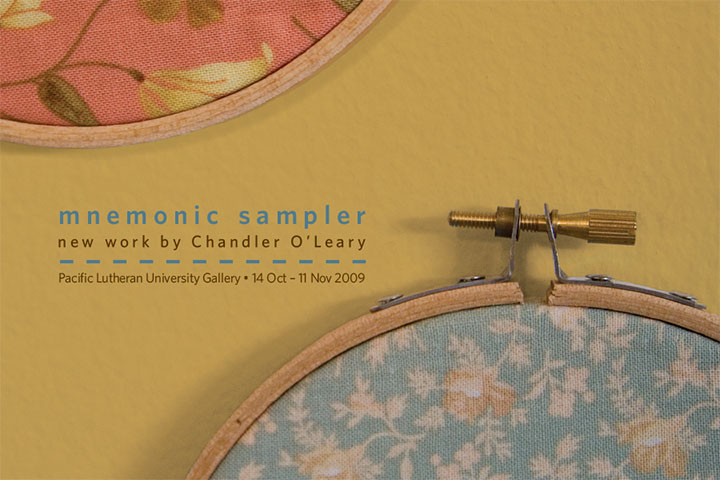
Finally, something tangible to show you! This is the point where all of the elements for my new body of work are just starting to come together. The past couple of months have been somewhat of a nail-biter—sometimes I wonder what possessed me to create twenty-six new pieces for a last-minute show. Now that the promo postcards (see above) are in hand and I can see the finish line, however, I can tell that my instincts knew what they were doing.
Mnemonic Sampler is my new solo show, opening October 14 at the PLU University Gallery. Here are the details:
Mnemonic Sampler: An Abecedary by Chandler O’Leary
October 14 to November 11
University Gallery, Ingram Hall
Pacific Lutheran University, Tacoma, WA
Opening Reception: Wednesday, October 14, 5-7 pm
On display will be something of a room-sized artist book, consisting of twenty-six hand-embroidered monoprints on calico (a monoprint is the opposite of an edition, a one-of-a-kind piece). Together the prints form an abecedary, or alphabet, and tell the story of how our concepts and ideals of “Home” are linked to the everyday objects that surround us. More on this topic when the show opens, but for now, here’s a peek (since the work is not quite finished, a peek is all I’ve got for now):
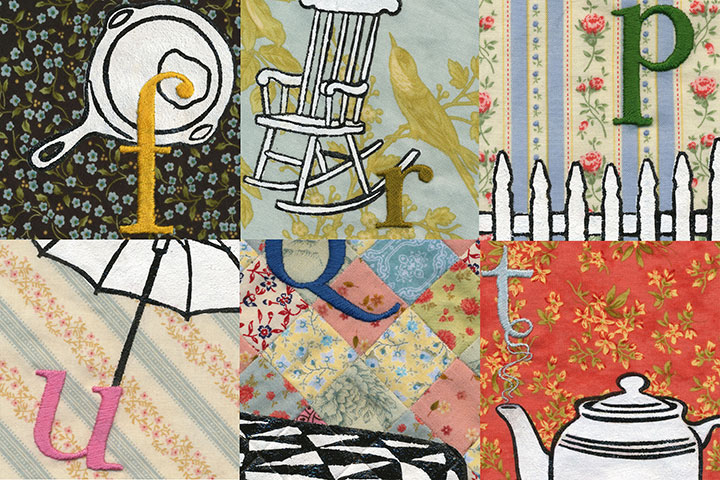
Many, many thanks to the talented and infinitely helpful Katie S. at PLU, who took care of having show postcards printed and mailed (!), orchestrated every logistic detail, and who has made the whole process as smooth as pumpkin pie. I would have long since lost my mind if it weren’t for you, Katie!
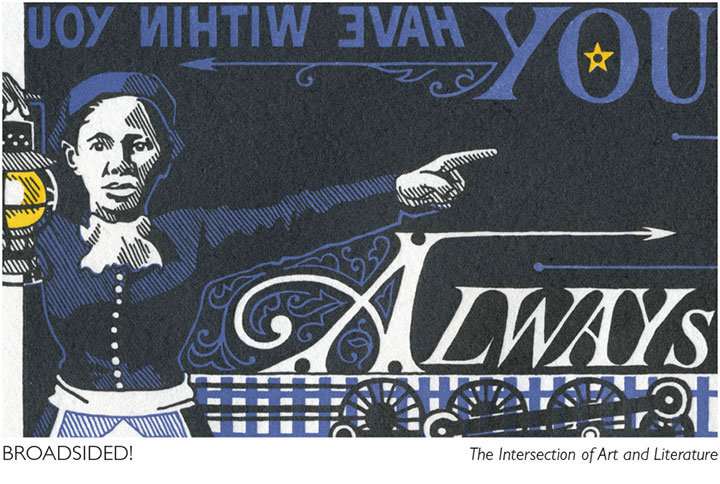
Speaking of amazing women who run galleries, another big thank-you and shout-out to Laura Russell of 23 Sandy Gallery in Portland, for featuring End of the Line on the promo materials for another new show that opens tonight. Broadsided! is national, juried exhibition of letterpress broadsides featuring the work of thirty-four artists. Here are the details from the 23 Sandy website:
Broadsided! The Intersection of Art and Literature
October 2-31, 2009
23 Sandy Gallery
623 NE 23rd Avenue
Portland, OR 97232
Opening reception: Friday, October 2, 6-9 pm
Before books, before blogs and before broadcasts, there were broadsides. Historically, single sheet broadsheet posters were ephemeral in nature. They were developed in the fifteenth century for royal proclamations, official notices and even advertisements. Today, broadsides hang at the intersection of art and literature. Letterpress printed broadsides are valued as fine art designed and printed by a true craftsperson; but also as fine literature featuring stellar poetry or prose.
The best part about the Broadsided! exhibit is that you don’t have to be local to see it! Laura has set up a fantastic online catalogue of the work in the show, with photos and the complete text from each broadside. Nothing beats seeing art in person, of course, but if you can’t make it to Portland this fall, this is a brilliant alternative.
September 25th, 2009

For the past several months, the buzz here in T-town has centered around the Luzon building on Pacific Avenue, a 119-year old structure that, depending on whom you ask, is either an architectural gem or a decaying eyesore. (As you can probably guess, I fall into the first category.) Above is an image of the Luzon in its infancy; this photo is printed from a turn-of-the-century glass plate negative found in Jessica Spring’s attic (and is part of her artist book, Parts Unknown). The thing about the Luzon that has made it such a sore spot around here is that it’s not just a living piece of history—at the time it was built, it was something of an engineering marvel. Co-designed by Daniel Burnham, who went on to design the Flatiron Building in New York and became one of the pioneers of modern multi-story structures, the Luzon was one of the first buildings in America to have steel columns. That makes it a direct ancestor—the great grandpappy, if you will—of the American skyscraper itself.
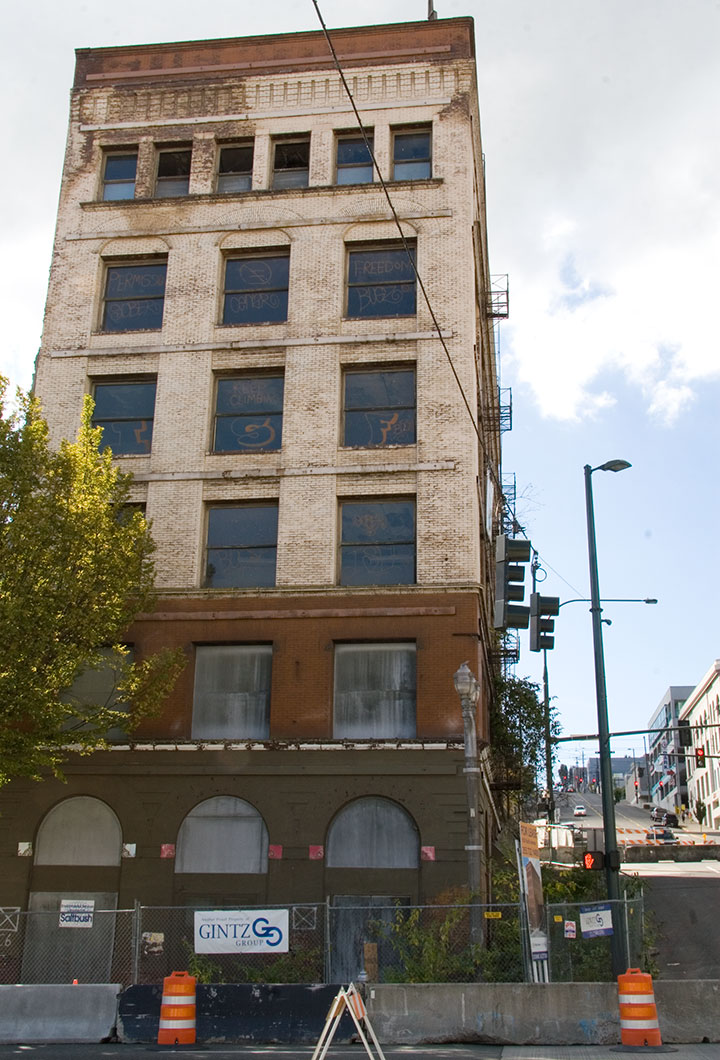
This is the sorry state of the Luzon today. Even though it is on the National Register of Historic Places, and is one of only two Burnham & Root buildings remaining on the West Coast, it has been allowed to decay, apparently beyond the point of no return. While each of many redevelopment schemes over several decades has fallen through, the building has become increasingly derelict. Now that the adjacent property—which provided structrual stability—is long gone, the Luzon is crumbling under its own weight. The City has even closed the surrounding streets in case of a collapse.
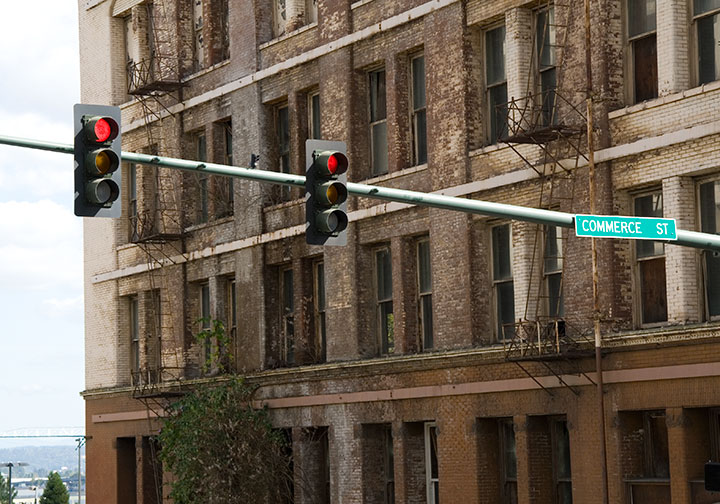
Oh, and there’s a tree growing out of it. I don’t think that was part of the original plan.
Well, whether it was a ploy to get around the Historic Register for a development scheme, or the powers that be just dragged their feet for too long (or some combination thereof), the detractors are finally getting their wish. The building is slated for demolition tomorrow morning. So now everyone (including me) has got the Luzon on the brain.
Last week the inimitable artist/cartoonist RR Anderson (who has a few choice words himself about the Luzon’s fate) challenged me to compete in his weekly sidewalk chalk contest, the Frost Park Chalk Challenge. I was looking for an outlet for my Luzon frustration, so I accepted. I grabbed a hunk of charcoal, a handful of communal Crayola chalk, and headed for a highly visible chunk of concrete wall to create a public altarpiece.
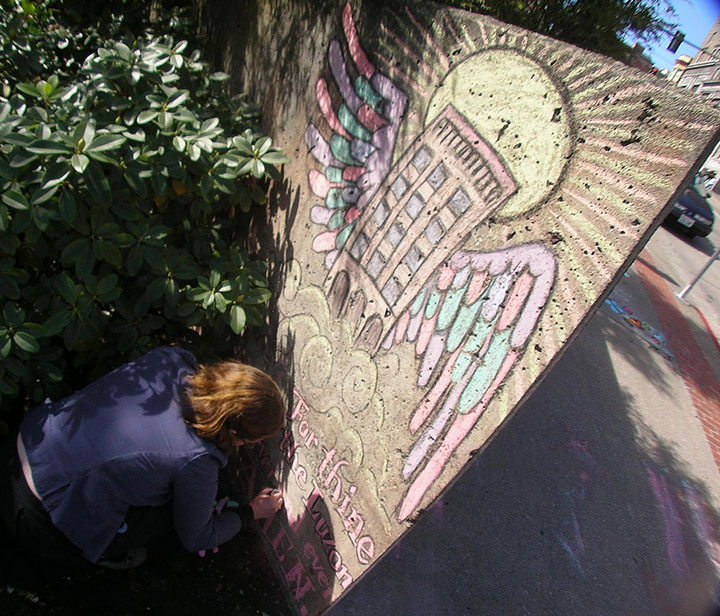
Photo by R.R. Anderson
My little Ascension doodle earned me a lot of comments from passers-by and the title of BEST ILLUSTRATOR IN THE UNIVERSE (OF TACOMA) for the week (thanks, guys!).
But sidewalk chalk isn’t exactly archival, and I wanted to make a somewhat more lasting statement. Here’s where letterpress comes in. Jessica and I were commissioned to design and print this year’s poster for Art At Work Month, hosted by the City. So since the theme for the overall Art At Work design this year is “ghost signs,” we decided the poster would be the perfect opportunity for a little cameo.
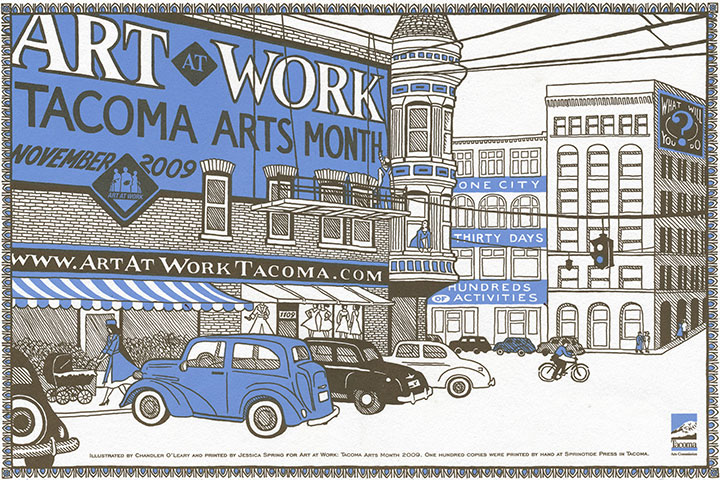
The original posters are letterpress printed in an edition of 100, and will be sold by the City in November, as part of the festivities. But a reproduction will also be inserted into every Art At Work brochure—over 10,000 of them. So come November Burnham’s gift to Tacoma will be long gone, but it’ll feel good to know that we did our part to make sure the Luzon is everywhere we turn—at least for a little while longer.
Edited to add: now that Art at Work month is over, you can now find the last few copies of the letterpress poster in the shop!
September 22nd, 2009
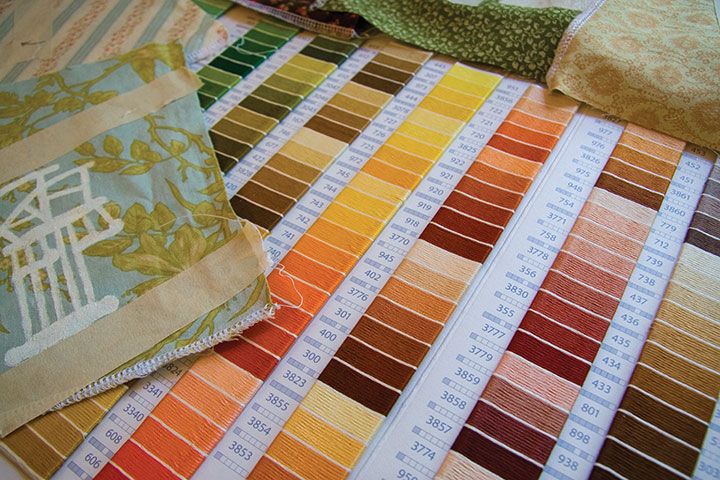
Swatch books are very near the top of my list of Favorite Things Ever. There is something so satisfying about having every color, pattern, texture, or finish right at your fingertips. I love sitting at my table, with a cup of tea in hand and six hundred sample chips spread out before me, ready for some serious color theory. (In case you’re wondering, this is the amaze-a-crazy DMC embroidery floss über color card. Well-made swatch books like this tend to be expensive to produce, and impossible to find once they go out of print. So if you’re into this sort of thing, I’d suggest snagging your copy before they decide to quit selling them.)
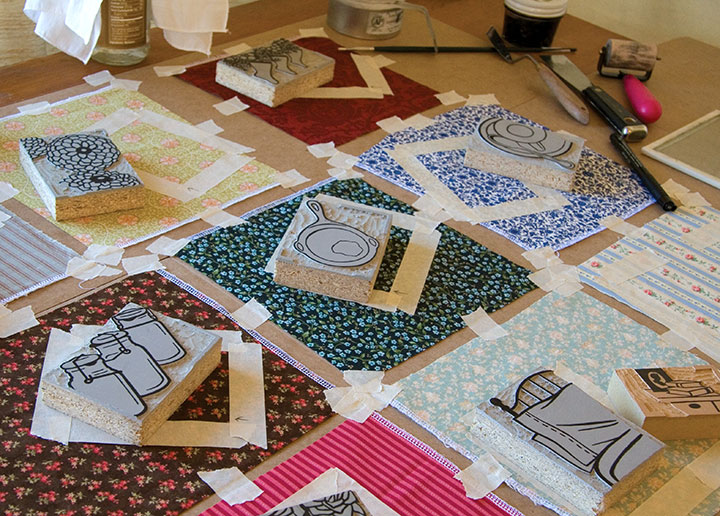
These days the studio has been an explosion of choices. Snippets of fabric and open dictionaries have taken over my life as I get ready for a new solo show, which opens October 14 at the Pacific Lutheran University Gallery. Stay tuned for more details in the next few weeks.
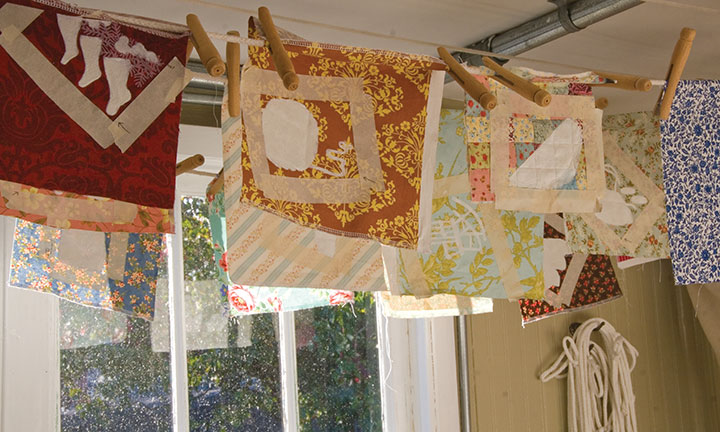
I wish I had something more concrete to show you, but this is one of those projects where everything comes together at once, right at the end (which can be as nerve-wracking as it is rewarding). I’ve got to say, though, that calico—finished or not—sure makes for pretty pictures.
August 12th, 2009
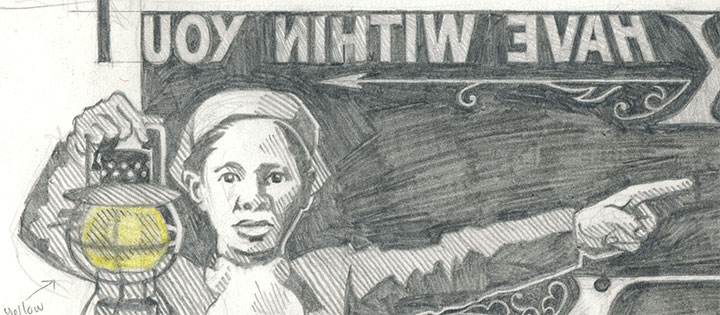
Jessica and I are almost ready to unveil the next Dead Feminist broadside! The ink is drying as I speak, so End of the Line will be available this Friday, August 14. For now, this is just a taste. Brush up on your mirror-reading skills, because this one is going to be a challenge. Stay tuned!
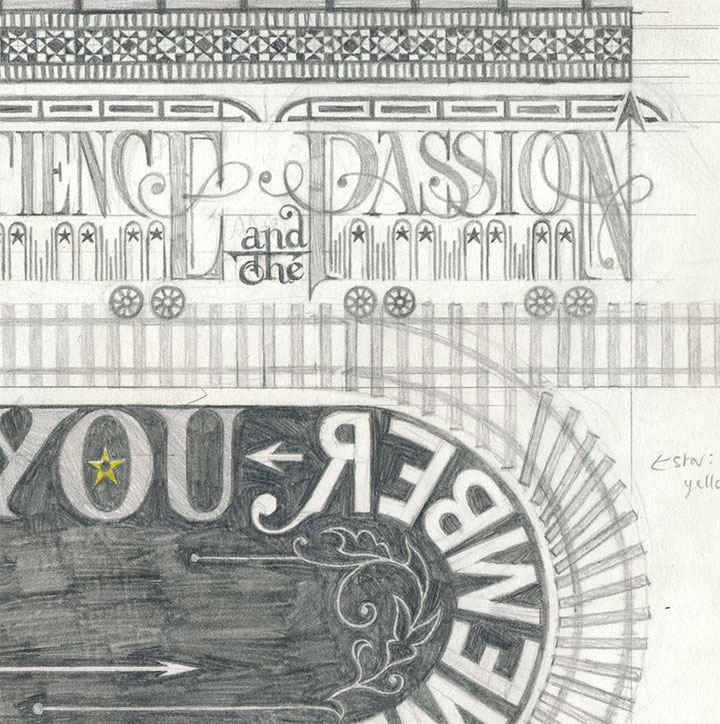
June 19th, 2009
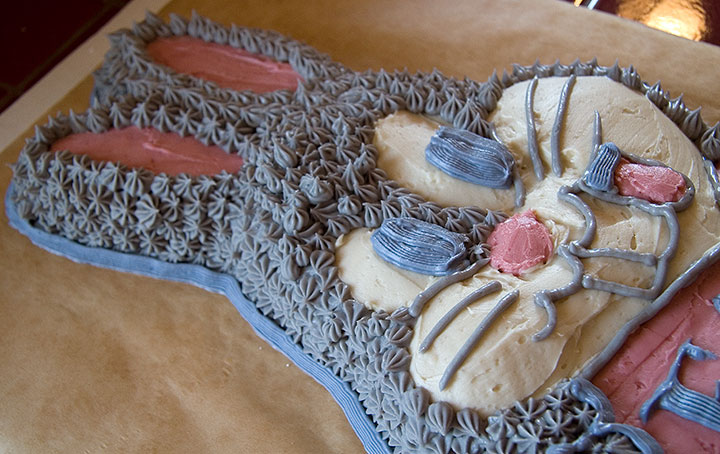
What with a string of out-of-town visitors and deadlines to distract us, the Tailor and I let our first anniversary slide by without much fanfare. This week, however, we remembered the nostalgic, circa-early-1980s, licensed-character Wilton cake pans we borrowed from his parents last winter, and decided a belated, totally un-wedding-like anniversary cake was in order. (Sane people just go out for a nice dinner.)
When I was a kid I loved the weird, hairy-looking frosting on those Cookie Monster and Pac Man cakes, but I don’t remember actually having one at any of my birthdays (I usually requested pumpkin pie, still my favorite). So this was my chance to both relive and rewrite my childhood—and to try my hand at creating that bizarre, strangely satisfying frosting texture.
The Tailor found a white cake recipe in our favorite cook book (we have three copies!), and we modified an icing recipe to include only butter, sugar, vanilla and cream (about the only thing you’ll ever see me using shortening for is cleaning letterpress equipment). Then I noticed that the cake mold left room to write a message in icing—and my eyes strayed to my decorating tip, which was shaped curiously like a calligraphy pen nib. So I couldn’t resist attempting a little edible typography. The cake wasn’t large enough to write “Happy Anniversary” with any typographic flair—and that’s not my style anyway. So I went with something a little more down-to-earth, and, well, appropriate to the medium:
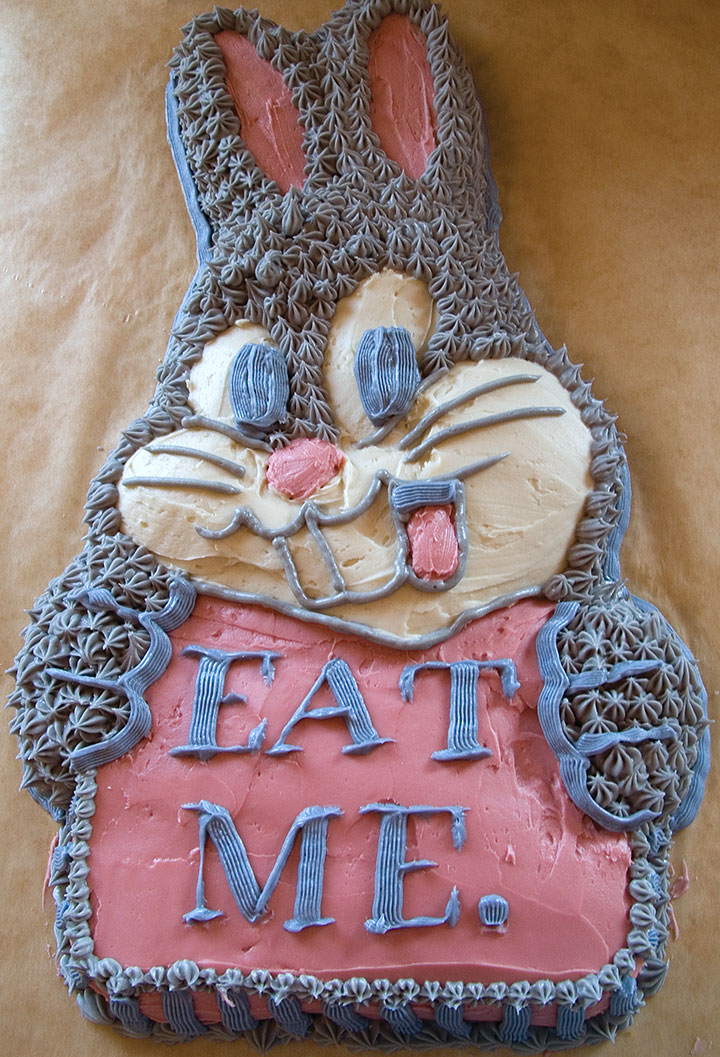
(We did. Most joyfully. My edible kerning needs some work, though…)
May 30th, 2009
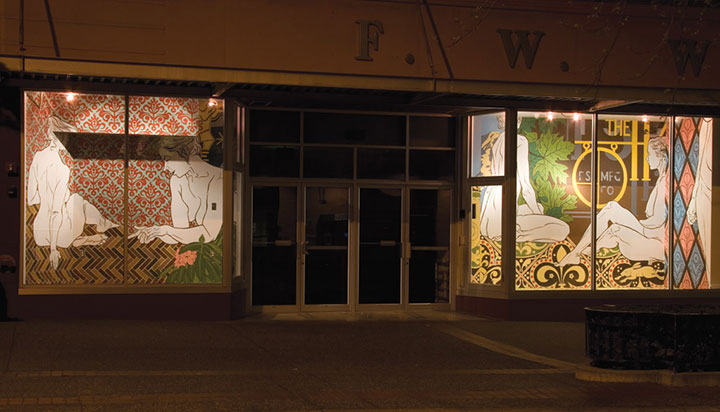
Oh, I’m probably asking for it with this post title. (To anyone who might have found this post by Googling naughty things, I’m afraid you’re about to be disappointed.)
The window displays in the old Woolworth’s store downtown have been converted into a twenty-four-hour gallery, with artist exhibitions and installations rotating quarterly. Shortly after I moved to Tacoma, I found out that they were accepting applications for the 2009 gallery slots. I thought it might be a good opportunity to try out a crazy idea I’d been playing around with, so I decided to give it a go.
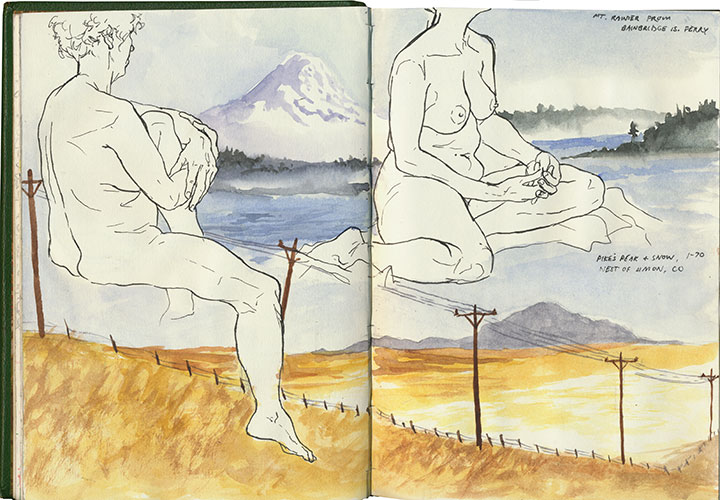
For many years I’ve carried a sketchbook everywhere I go, but for the last couple I’ve been experimenting with something a little different. One day I was in a hurry, and knew I wouldn’t have time to fill an entire spread with the watercolor sketch I wanted to make. So I chose a page that already had some figure drawings on it, and just painted within the negative space around the figures.
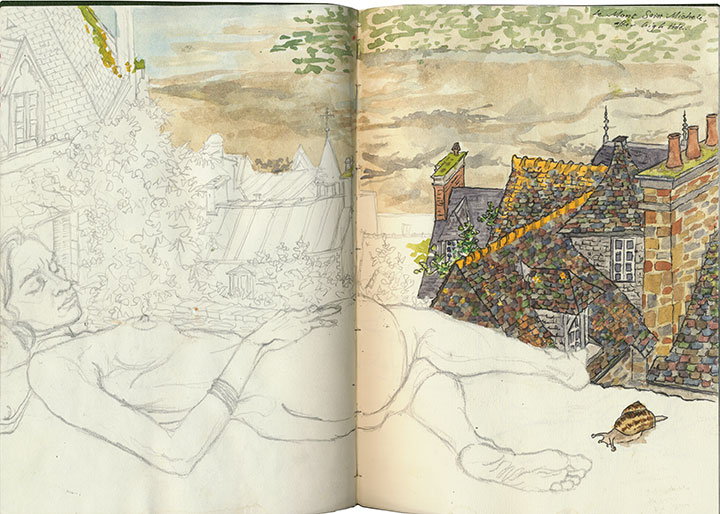
And from then on I couldn’t stop. Once the number of watercolor paintings began to catch up with my stock of line drawings, I started attending model sessions again. This time, though, I used the figure drawings to compose the page, with the expectation that eventually I’d go back in with another sketch later.
Several people told me they’d like to see these drawings on canvas or framed on a wall—and more than one suggested a wall mural version. Besides, the conceptual link between nude figure drawings and mannequins in a store windows was too tempting to resist. So I applied for a Woolworth Windows show, but I guess I never expected that my proposal would be accepted. I was talking about gigantic nudes on a busy street, after all. When the notification date came and went without a word, I assumed the project had been rejected and moved on. And then, three months later, I received an email that said, “Congratulations! By the way, your show begins next weekend.”
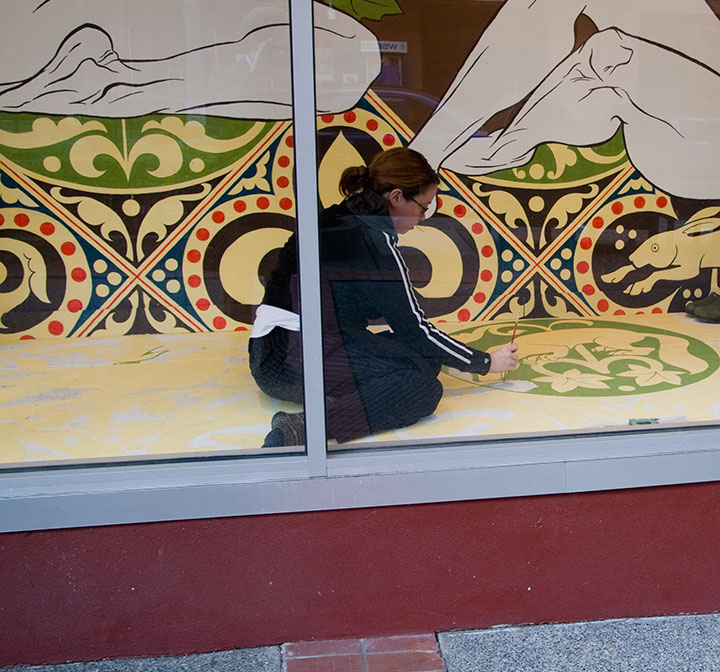
Now, I’m not normally an installation artist, but I do have six years of technical theatre and several large-scale murals under my belt. Still, there was something rather daunting about being thrown in the deep end of a double installation project, which involved attempting to paint proportionally accurate, ten-foot-tall nudes inside a narrow, very public glass box. A very monkey-cage-at-the-zoo glass box. To be fair, every mural I’ve ever painted has begun with a ripple of fear, and thoughts ranging from “Oh, right, I forgot how big walls are,” to “For the love of Pete, how did I ever convince these people that I was capable of painting something that actual humans would be able to see?” Depending on the scale of the project, of course—hey, if blank pages can be intimidating, blank walls (and tall ladders) are pretty terrifying. So this time, what with the many passers-by glancing in at me, I needed a few extra deep breaths. It’s funny that I still get that little moment of panic—because once I finally start in with either pencil or brush, I feel right at home, and even the ladder becomes an old friend. There’s just something so satisfying about slathering paint on a wall.
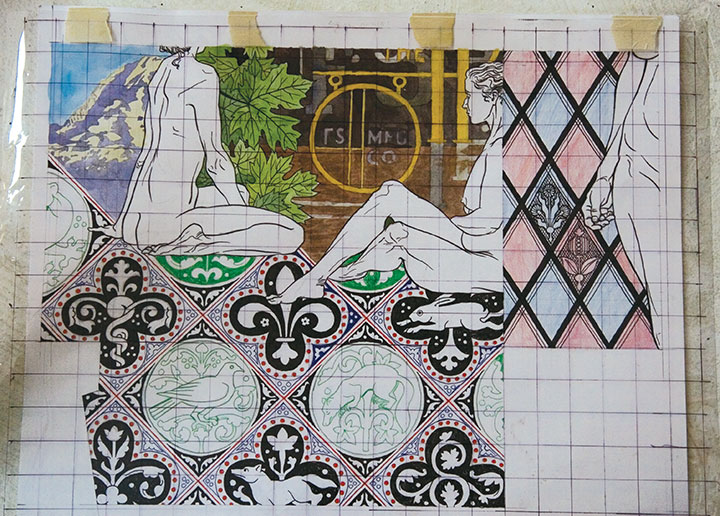
One of the challenges of the Woolworth Windows was getting my design up on the wall, at the correct size, without distorting anything. If I were painting a scenic flat for the theatre, I’d just photocopy my design onto a transparency, hook up a projector, and blow up the drawing to whatever size I needed. In a window display, however, there simply isn’t room to put a projecter far enough away from the wall. So I did it the old fashioned way: made my rendering to scale, laid a grid over it, and drew the same grid at the larger size on the wall.
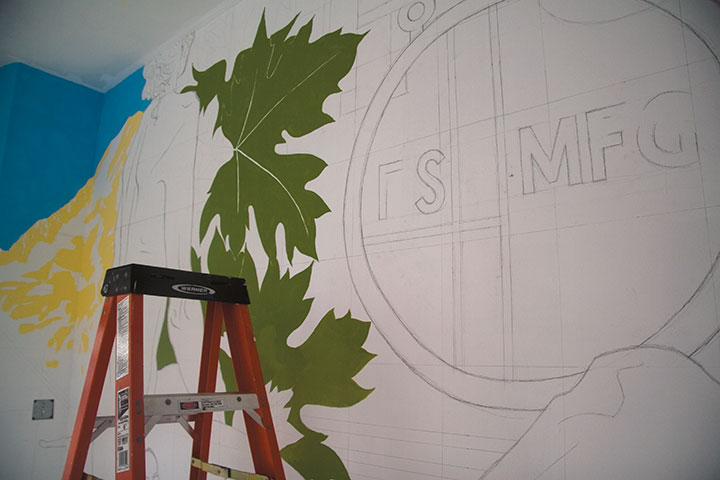
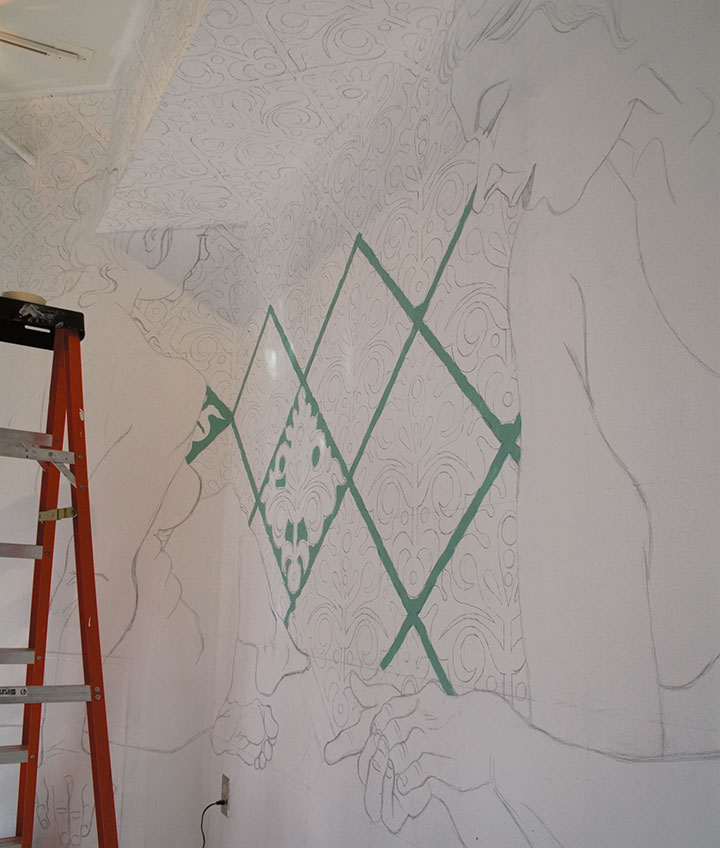
You can see a little of the pencil grid in the top photo; in the left-hand window the pattern repeats did most of the work for me.
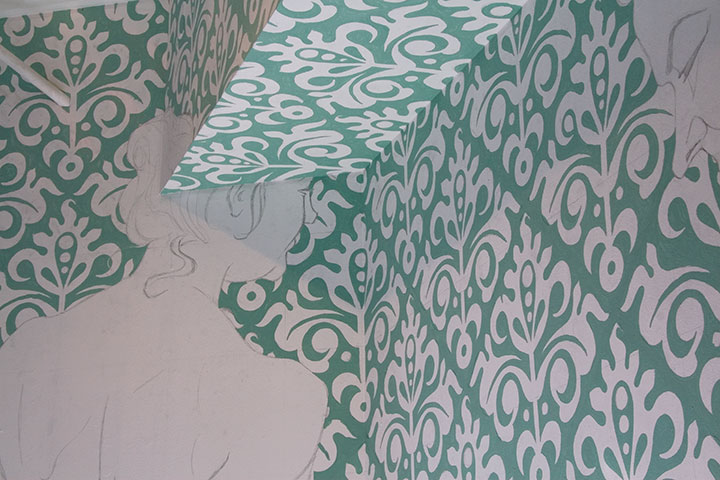
Like the drawings in my sketchbook, the inspiration came from a variety of sources. This pattern was an original design, but I was heavily influenced by the patterned brocades I saw at Versailles (see below).
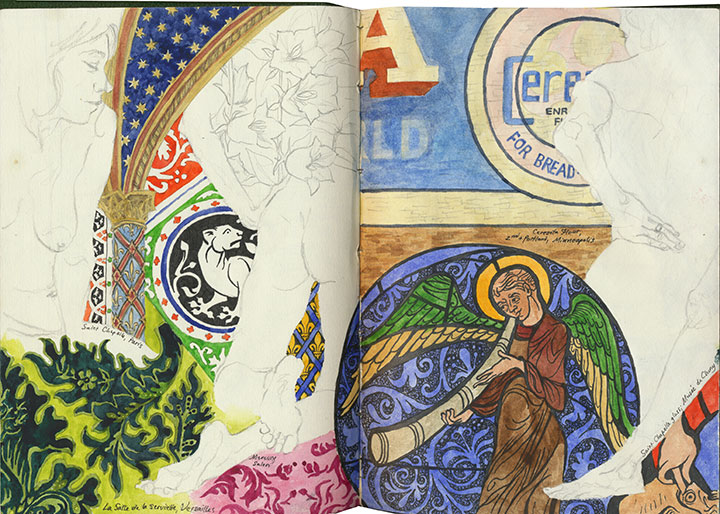
Another element from this sketchbook page found their way into the design—my drawings of the inlaid floor of Saint Chapelle in Paris became the basis for the floor of the right-hand window.
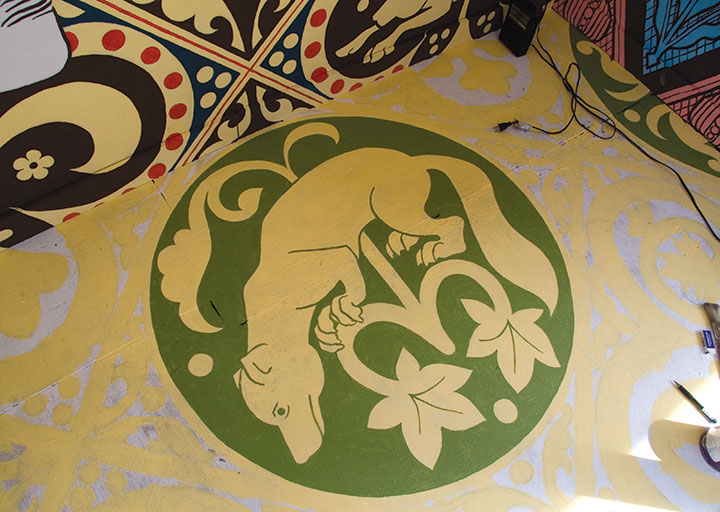
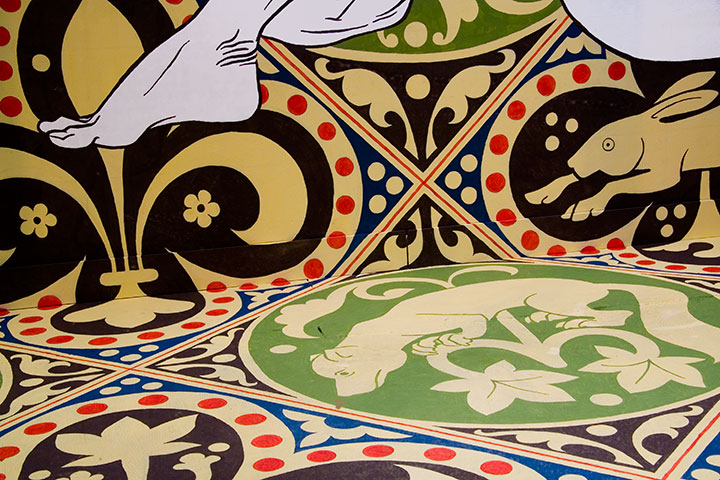
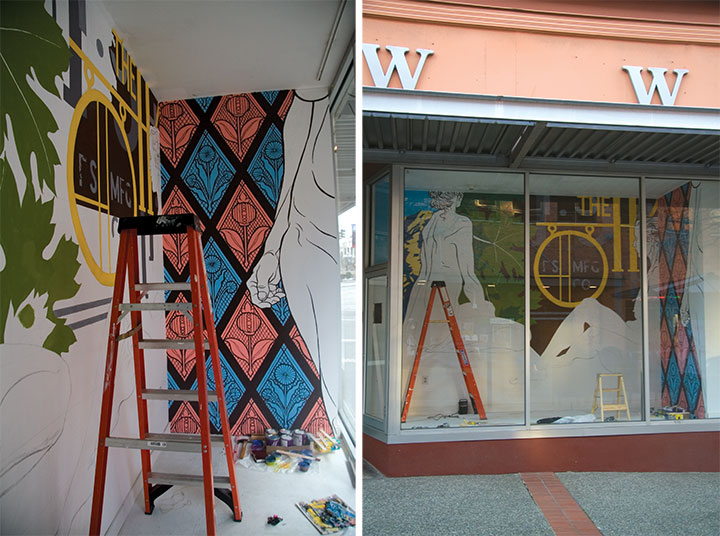
The windows also contain elements found closer to home: bits of historic Tacoma signage,
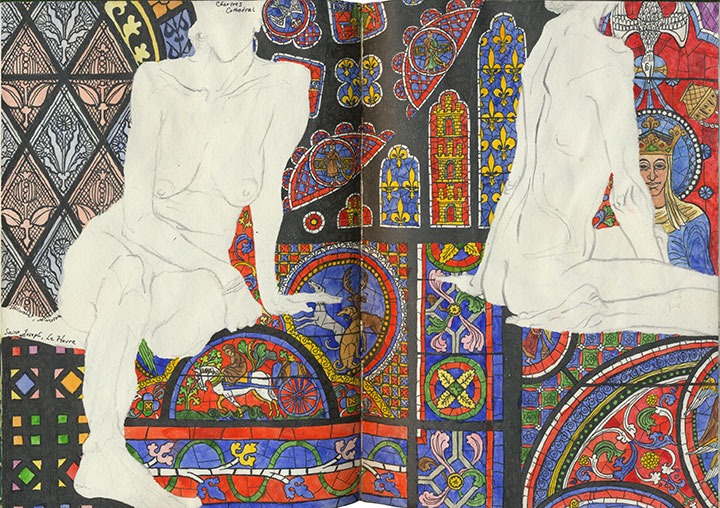
and a stained-glass window in the home of my friend Christina, who lives in a former church.
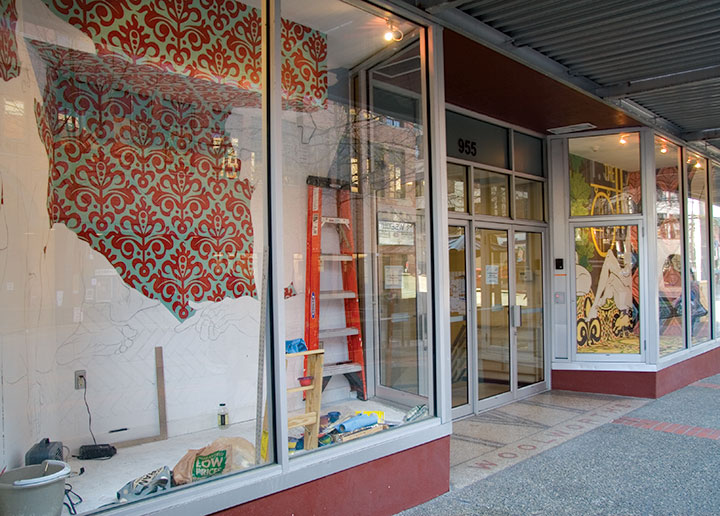
Since I had a lot of equipment to stash in such a small space, I had to paint in a piecemeal fashion,
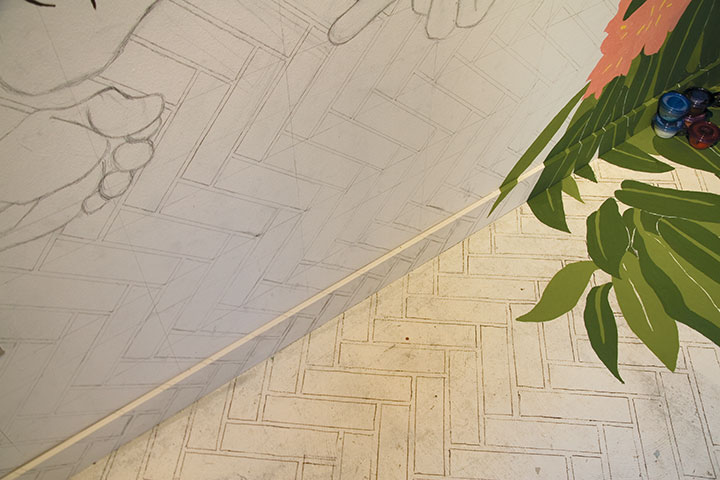
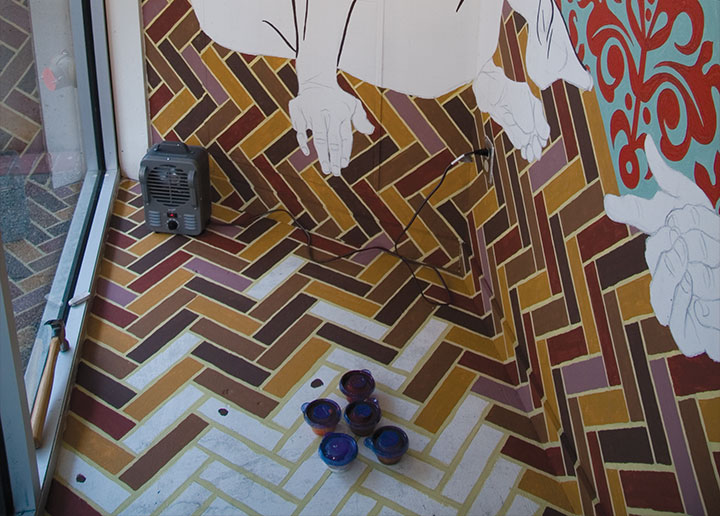
moving my supplies closer to the door as I painted myself into a corner.
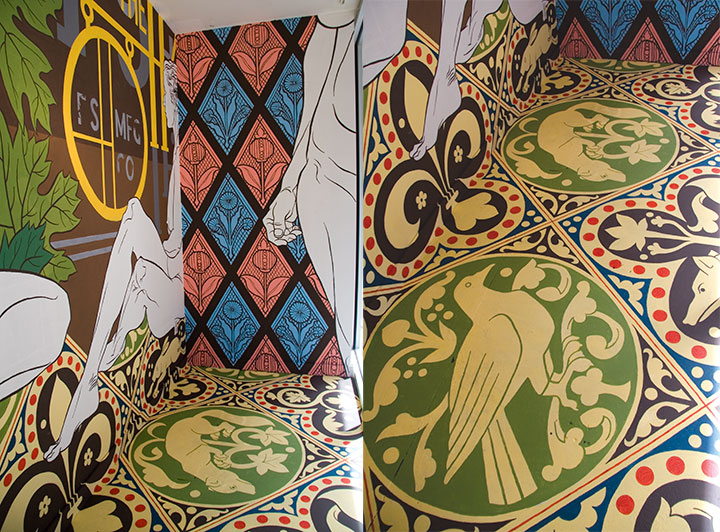
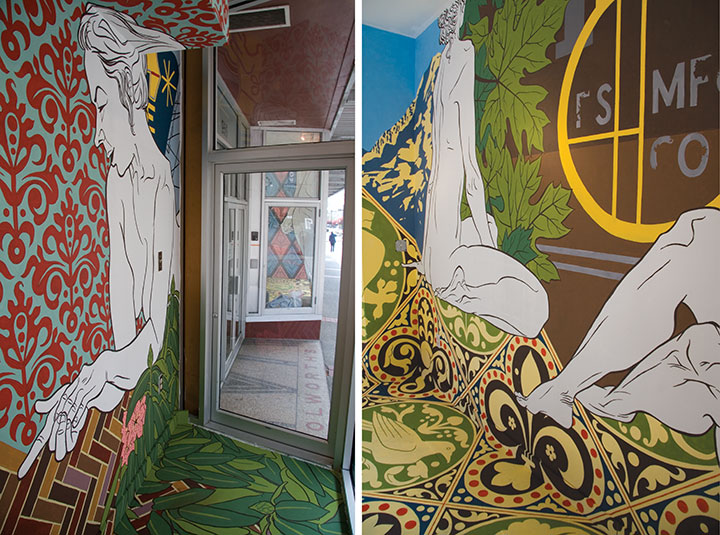
Despite the challenges of the installation, this has been one of the most interesting and fun mural projects I’ve ever done. For one thing, I fulfilled a secret childhood wish to be “one of those people” who designed and created window displays (I was a big fan of Mannequin). For another, the best part about painting in public is that you get to meet all kinds of wonderful people. Everyone I’ve seen has been incredibly supportive, curious, and thoughtful. Mothers wheeled their strollers right up to the window so their toddlers could press up against the glass and watch. School kids on a field trip gathered around my rendering and recognized the Harmon sign immediately. Street-smart teenagers stopped to ask insightful and challenging questions about gender roles in art. Friends brought me coffee on a chilly day, or kept me company when I started to get tired. Business people flashed me a thumbs-up on their way to work, and neighborhood regulars shouted their encouragement through the glass. I guess I didn’t have to worry about the public reaction to a bunch of naked ladies after all.
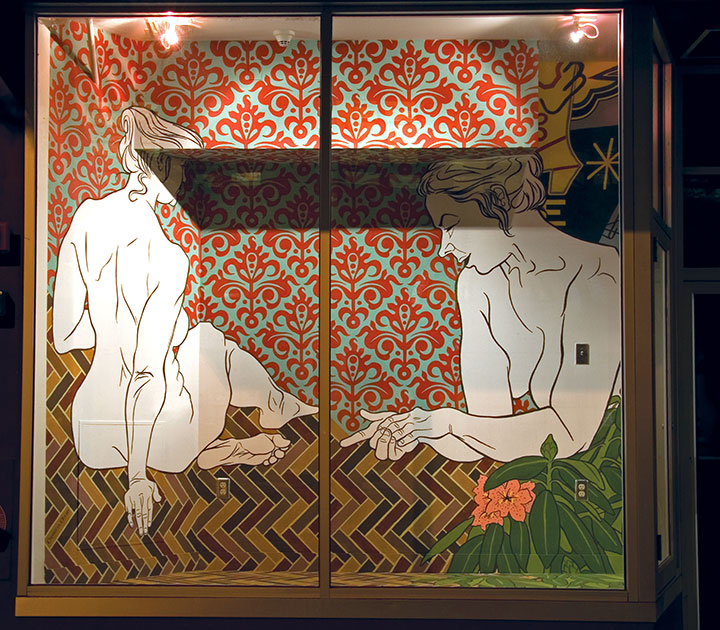
There’s a catch to all of this, however: the installation is temporary. The last day of my show is June 13, and then I have to paint everything white once more. So stop by while you can—you’ll find these ladies on Broadway, close to the corner of South Eleventh Street (on the same block as the Thursday farmer’s market).
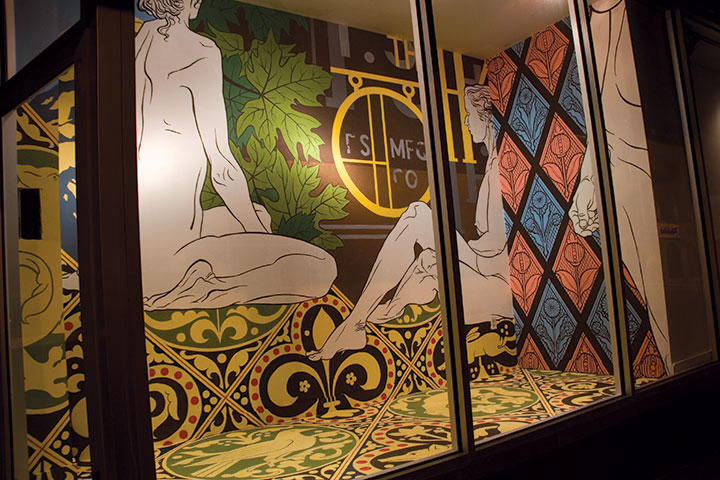
I guess that’s another thing all those years of theatre taught me: how to practice a little detachment when you have to dismantle what you built.
Even if it were only up for a day, though, it would have been worth it.
May 16th, 2009
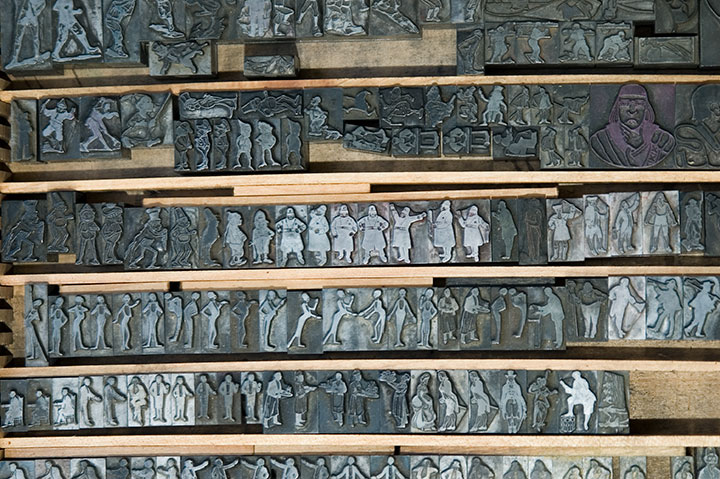
When it comes to letterpress printing, process is everything. And since that process is not always evident in the final product, I thought I’d share the technical aspects of the Dead Feminists series. Now, as I said in the last post, letterpress printing is traditionally done using metal or wooden type—or in the case of the photo above, relief images cut into type-high (.918 inches in the US and UK, in case you wondered) blocks. What Jessica and I have been doing, however, ain’t your grandpa’s letterpress. Thanks to a fairly new technology called photopolymer, we’re able to create our own relief plates right in the studio, without having to carve a block by hand or etch a plate with nasty chemicals. Photopolymer has also created a bridge between the traditional print shop and the modern digital world—as you’ll see in a moment. As far as the Dead Feminists go, Jessica and I still have both feet firmly planted in the traditional world—we just dip a toe into the digital realm now and again. Here, let me explain.
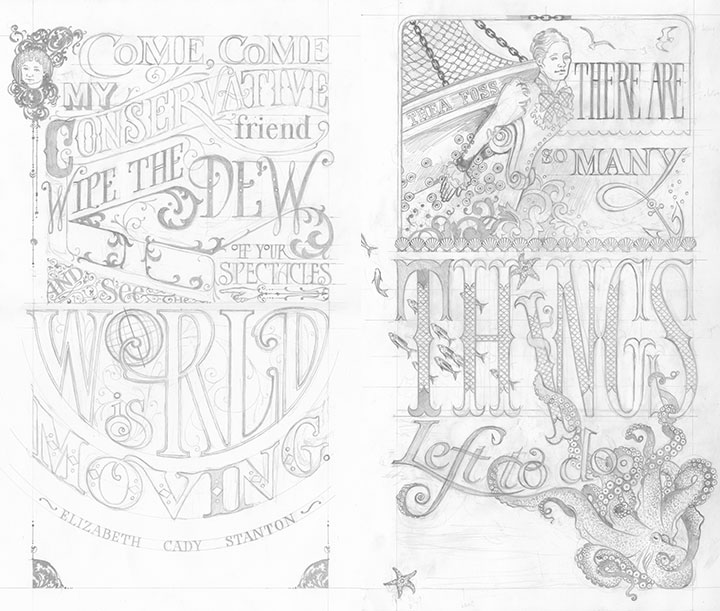
This is how it begins for each print: a pencil drawing, at full size. This is the stage where I not only design and illustrate the piece, but also start thinking about color choices: what the colors will be, what element will be which color, where the colors will overlap, how to make things work logistically. Now, this pencil layout isn’t enough to make a plate; for the photopolymer process to work properly, I have to translate the sketch into a solid black-and-white ink drawing.
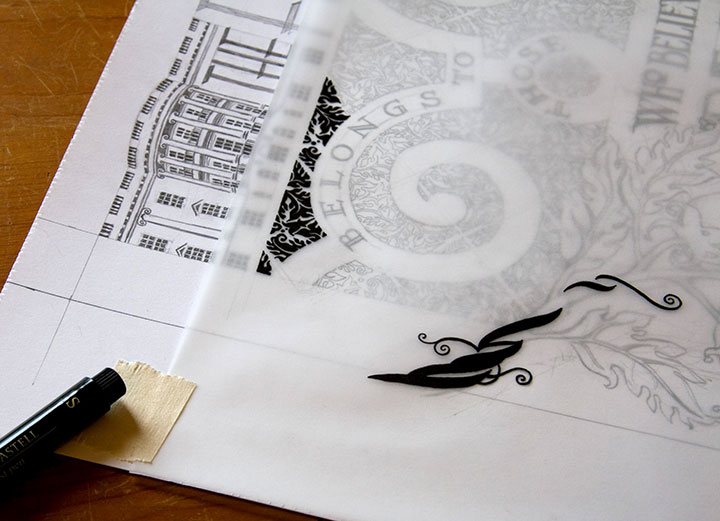
After everything is pencilled in, I lay a sheet of vellum over the drawing and trace everything in ink.
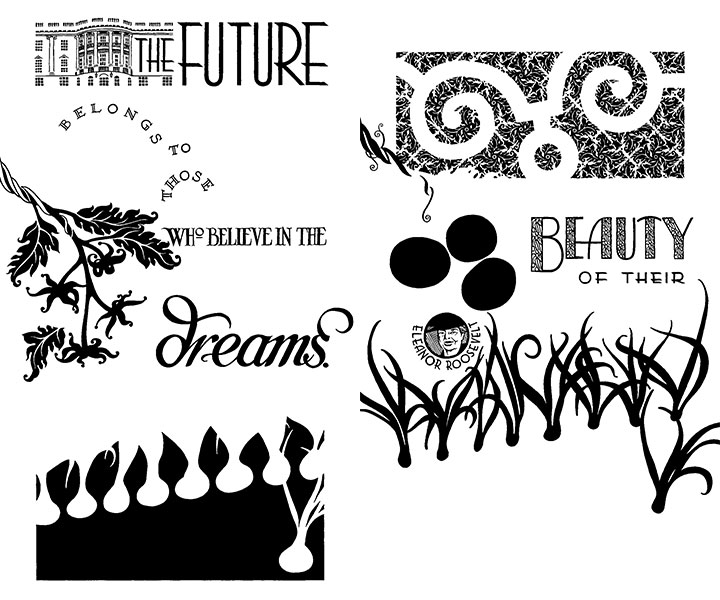
Since each broadside is printed in two colors, each color means a separate run through the press. So as a result, I had to trace each color separately—being careful to stay as true as possible to the original drawing, since the colors had to line up exactly on press. If you were to line these two color separations up, on top of one another, you’d see how the colors will interact in the final piece.
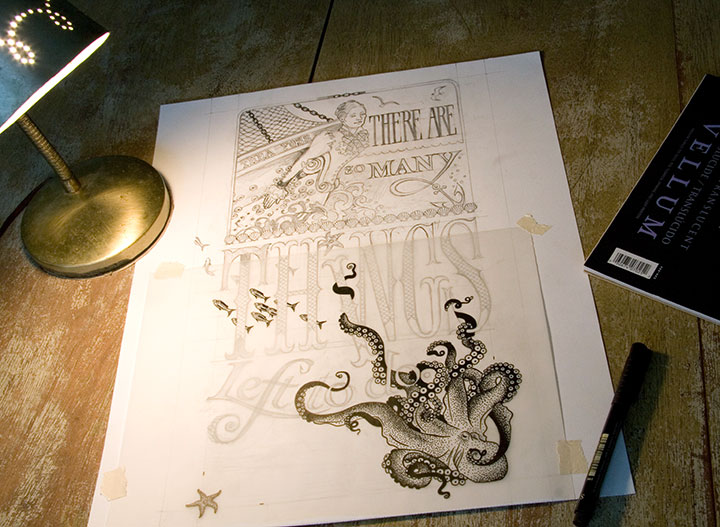
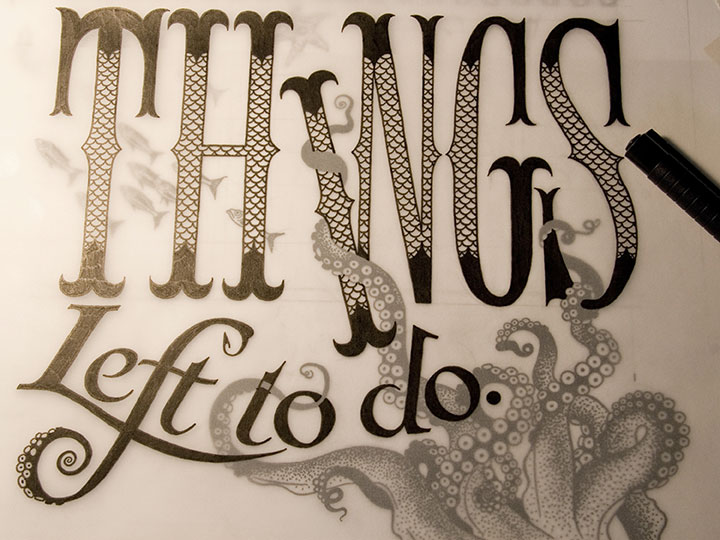
Here’s what I mean. You can see the separation that will become the grey color in Tugboat Thea here, laid directly over the inked octopus below. This is definitely the old-fashioned way of doing things; there are plenty of digital methods of color separation. I guess I just prefer the physical connection between the pen and the hand—even despite the greater risk of screw-ups (as you can see if you look closely at the word “to” above).
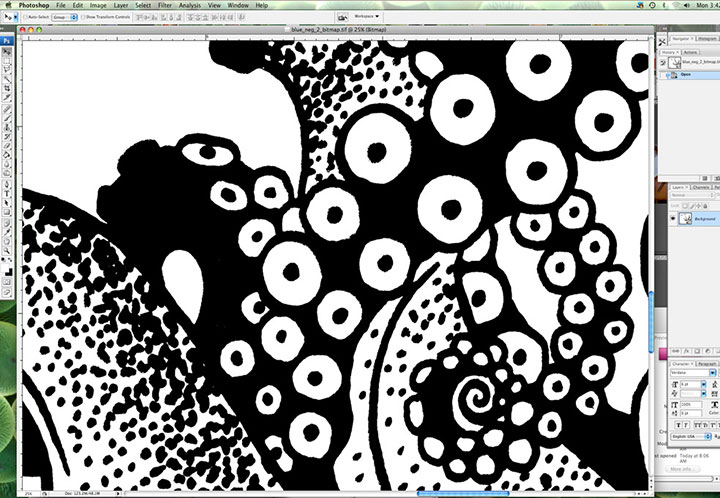
Here’s where I dip that toe into digital waters. Once I’m finished inking, I scan the finished line drawings at a super-high resolution and load them into Photoshop. This is where I clean up any mistakes (ahem) and convert the drawings into bitmap (pure black and white, with no grey) files. Jessica sends me her written colophon, and I set the text digitally. Then I export everything to the proper file type, and send the files to a local service bureau to have film negatives made. So now we’ve gone from analog to digital and back again.
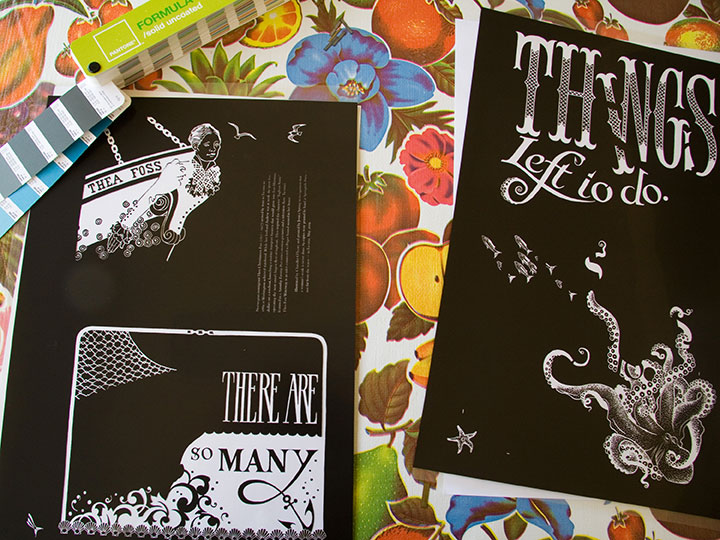
Here are the negatives for Tugboat Thea; grey separation on the top half of each one, teal on the bottom. As you can see, there aren’t any right angles in the bottom half (octopus) of the teal separation, so if you look closely you can see the little tick marks I added (above and to the right of the starfish) to aid with color registration. Those marks line up with a grid etched on the metal base we use to lock up the plates on press; once we had the plates exactly where we wanted them, I simply shaved those little tick marks off with an Xacto knife, so they’d no longer print. Real slick.
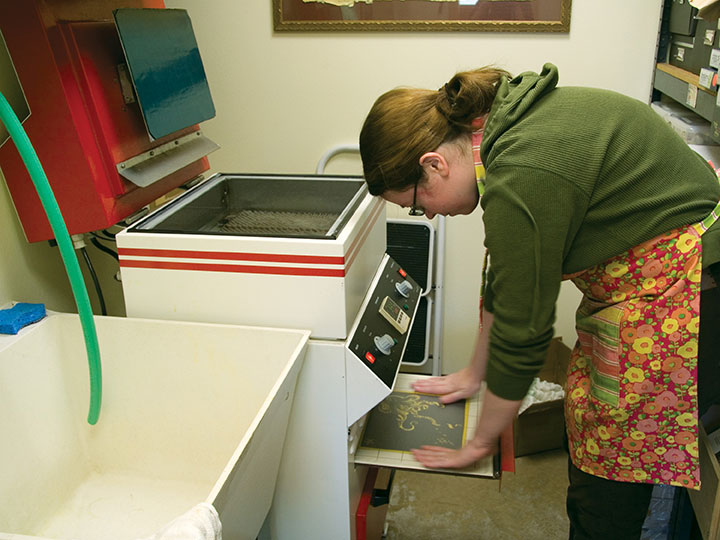
Anyway, photopolymer is a light-sensitive plastic that works just like making a contact exposure in a darkroom does. First I take a negative, place it face-down on an unexposed plate, and load both pieces onto the exposure tray of Jessica’s platemaker (which looks remarkably like an Easy-Bake Oven).
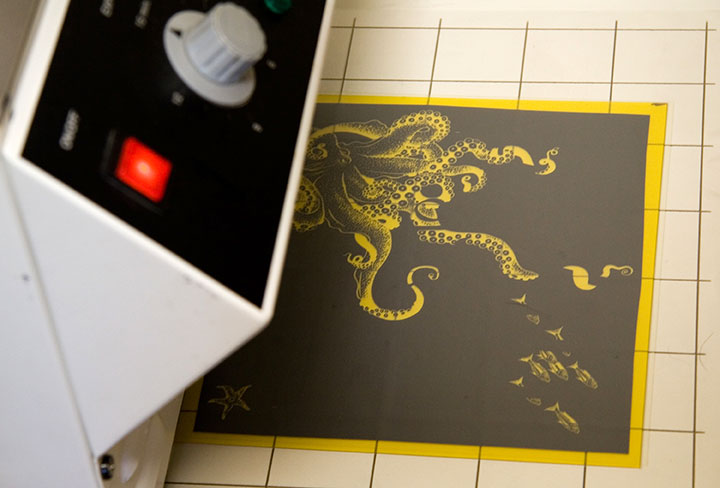
The negative is held flush with the plate by a layer of plastic and a vacuum system; the plate is exposed with UV light (some DIY enthusiasts also accomplish this using glass and a bright, sunny day, but photopolymer is awfully expensive to use in sketchy experiments in the cloudy Northwest).
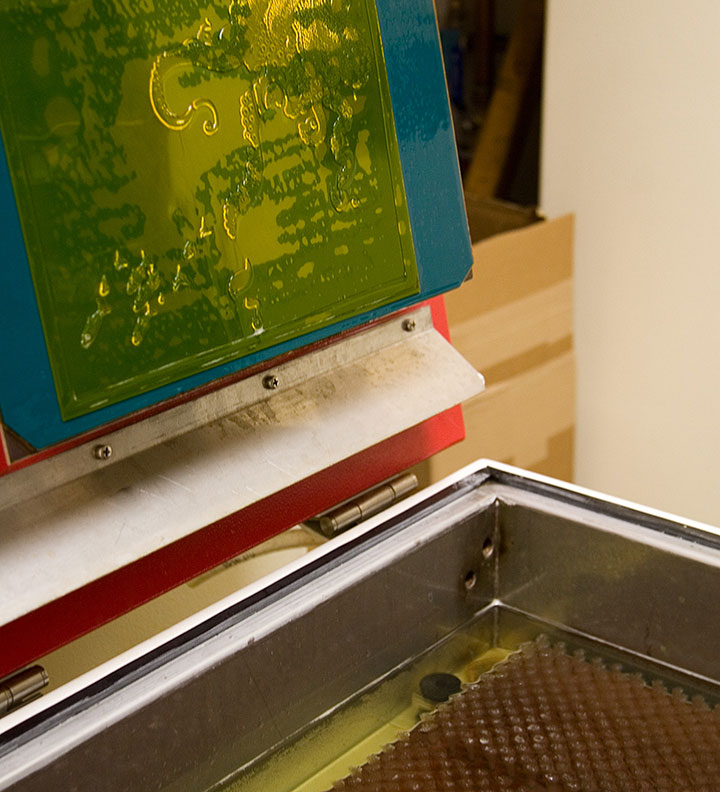
Next I place the exposed plate in the wash-out unit, where it is scrubbed gently with soft bristle brushes in a tank of cool water. Everything that is exposed is hardened enough to resist scrubbing, while everything else dissolves away. (And turns the water a sickly shade of yellow. Mmmm….plastic byproducts. Still, it’s less toxic than many other printmaking techniques.)
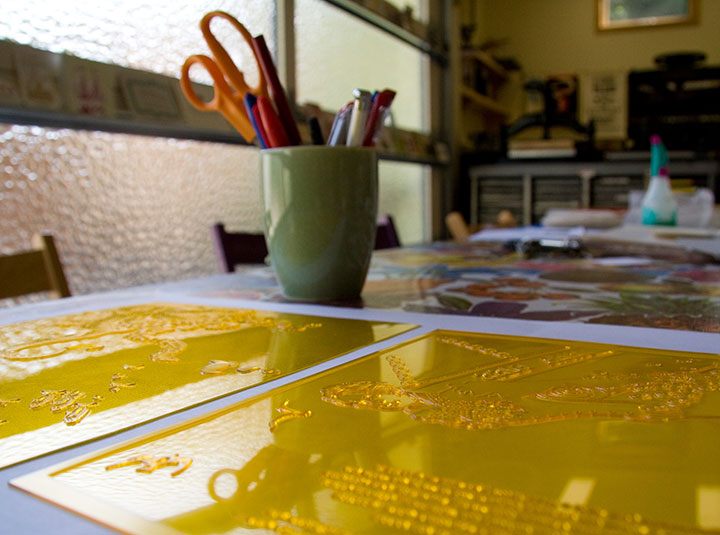
What we’re left with is a raised plate ideal for relief printing. The real benefit of photopolymer is that it can reproduce nearly any image, and can hold an incredible amount of detail. I can transfer my drawings directly to the plate, without adding the laborious step of carving the image into wood or linoleum (backwards!), or etching copper with acid, for example. It’s not exactly an economical option for letterpress printing, but the results can be exquisite, and the possibilities are nearly endless.
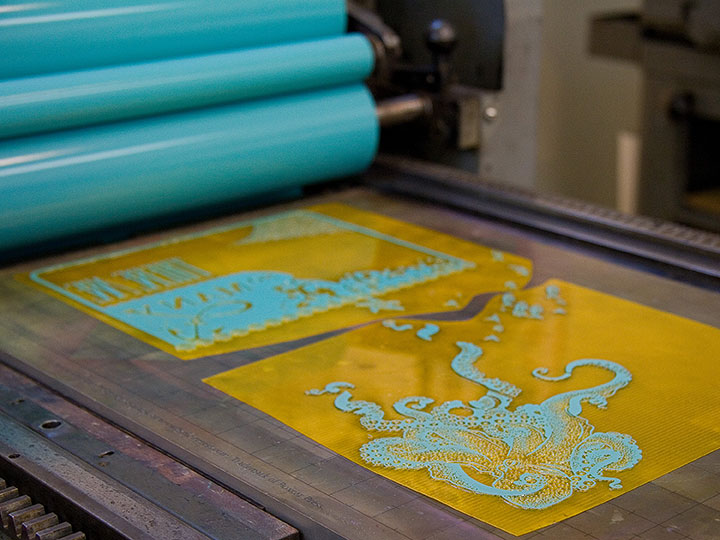
Here’s our new octopus plate on press, all inked up and ready to print—it’s stuck to that gridded base with removable adhesive. The thickness of the plate and base together add up to exactly .918 inches. Ah, precision feels good.
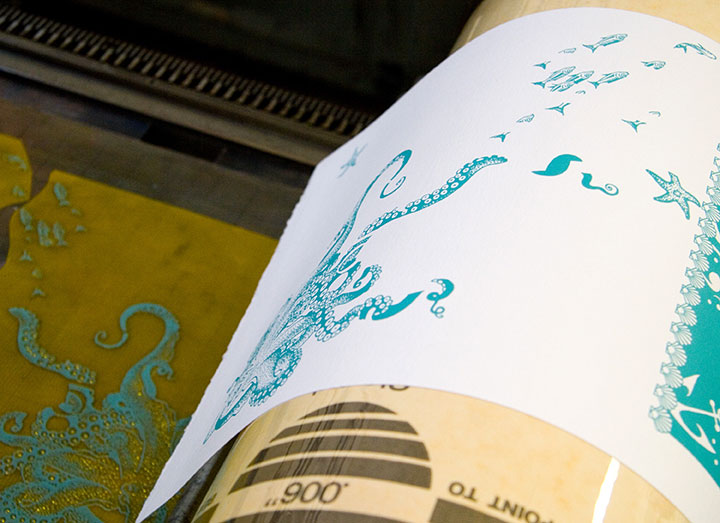
And here’s how it looks on paper.

Here you can see the registration between the colors. This is the hard part—I’m sure that despite my best separation efforts and useful tick marks, Jessica is ready to tear her hair out whenever she sees what insane registration issues I’ve thrown at her this time. She’s not a master printer for nothing, though—tiny, 9-point colophon type? No problem! Large, solid color blocks? Bring ’em on! Exacting registration with no margin of error? Sigh. Just get those plates locked up, will you?
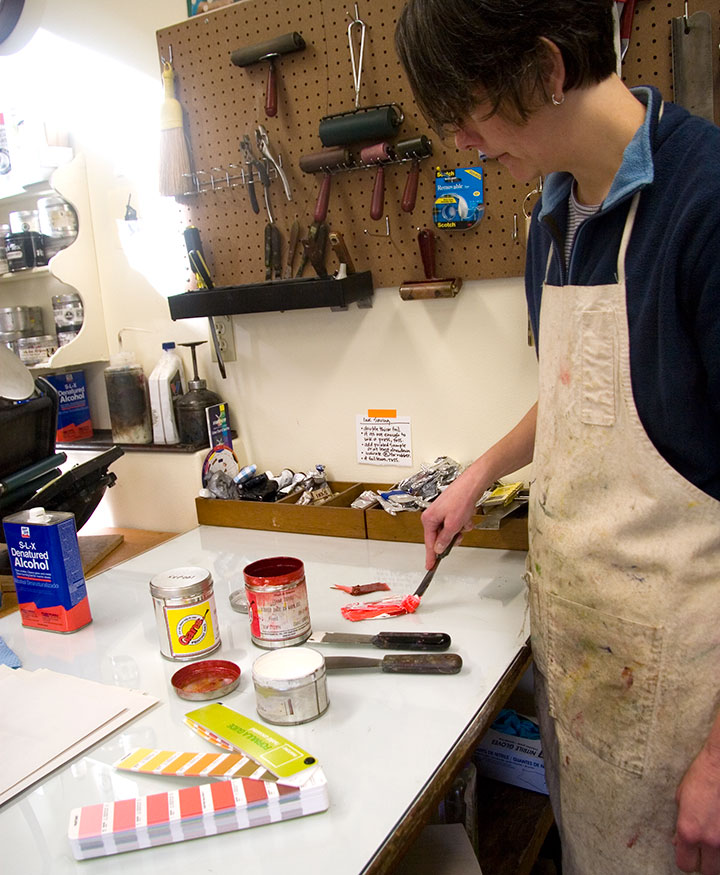
Actually printing these broadsides is where all our careful planning and preparation goes right out the window. We can sketch and plot as much as we like, but many of our artistic decisions end up being made on the fly, right on press. Here Jessica is mixing ink for Prop Cake, according to some choices I suggested in our handy-dandy color recipe book.
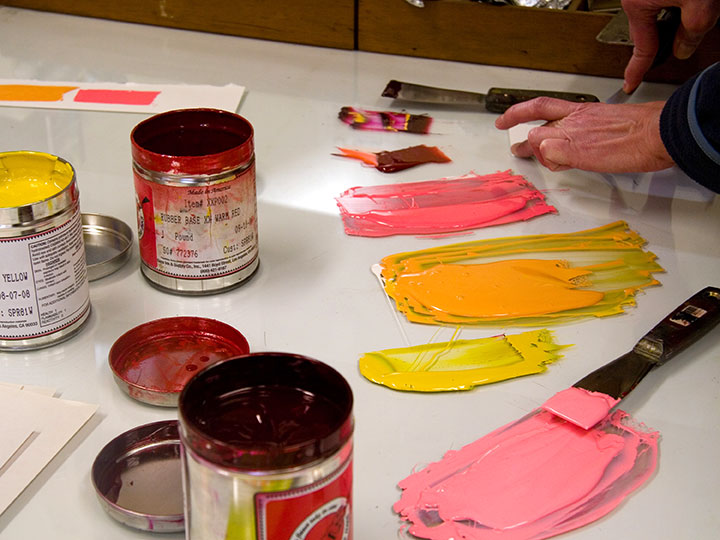
You can see our original draw-down (color test) in the upper left corner. So far, so good.
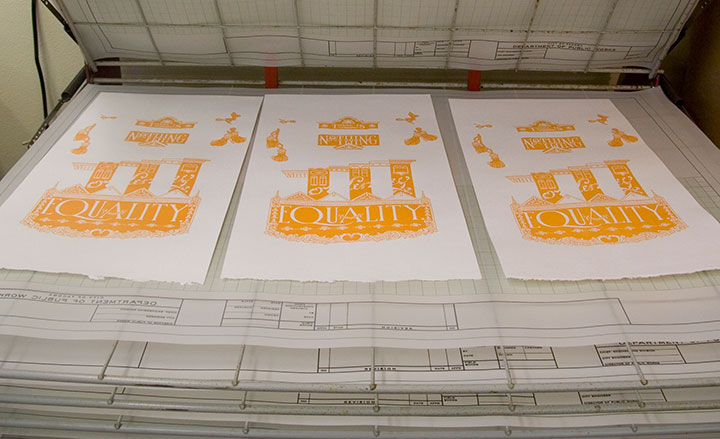
The orange turned out exactly as we’d hoped, but when we started printing the pink separation, we hated the result. What looked so good in the draw-down lost all its contrast in the print. It was awful, trust me.

So Jessica changed the color right on press, until we were happy with it.
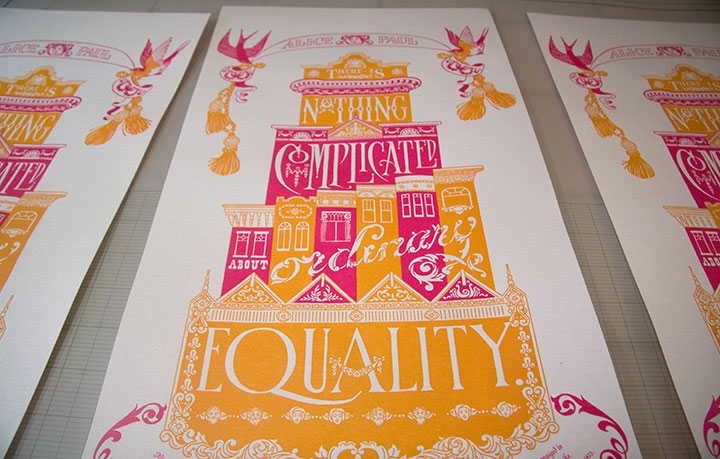
Here’s the finished product, all lined up in the drying rack.
If lining up the color areas is the hardest part of printing, keeping an eye on the ink consistency was probably the most fiddly. We’re using a very unusual paper for the series—one made from recycled clothing—that is extremely “thirsty.” Not only are there inconsistencies in the paper that can throw off the overall quality of color; but we had to add ink to the press after every fourth or fifth print. As you can see, this is a pretty organic process—lots of variables, small corrections and compromises along the way. (And a whole lot of cursing and starting over.)
All of this is par for the course for a letterpress project—it’s an exacting, sometimes frustrating process, but that’s what I love about it. And the finished product … well, it’s like nothing else. Ah, letterpress, how I love thee.
Now if only it didn’t require several metric tons worth of equipment…
May 14th, 2009
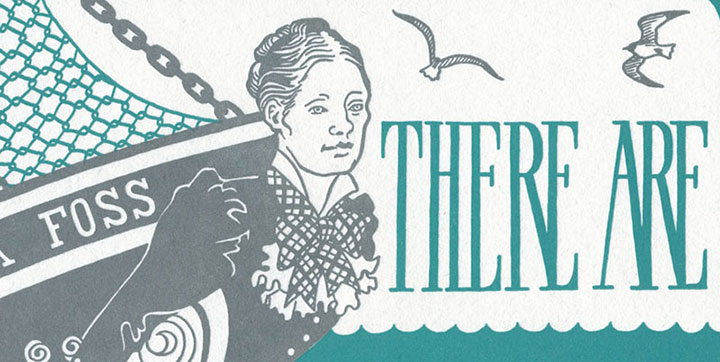
Holy cannoli, everyone! I’ve only just now come up for air—I’ve been buried under invoices, subscription forms, kraft mailers, and email print-outs, and Thea’s face is repeated all around me as reserved copies are spread all over the studio. Since I posted her here on Tuesday night the orders have just poured in, and over three-quarters of the edition is spoken for already. And Prop Cake is disappearing fast, too; we’re down to our last handful. Wow—just…wow. Thank you all so, so much.
Since Thea and her fellow Dead Feminists have left T-Town to be shipped all over the country (and to lovely Canada, France, Switzerland and the UK, too!), I thought it appropriate to share some of the things Jessica and I talked about at TAM the other day with a wider audience. Now, normally my paralyzing fear slight nervousness while speaking to a crowd manifests itself by wiping my memory clean immediately after I give a talk. It’s a very annoying thing, not being able to remember what you just said, but it happens all the time. I guess I’m fortunate that my phobias don’t show up as a quavering voice or profuse sweating (so nobody ever believes me when I say I get stage fright), but selective amnesia isn’t much of a fair trade for fake confidence! But this time, weirdly, it didn’t happen—I remember almost everything, and I think it’s because I wasn’t alone. (Jessica, I reckon that means you’re doomed to be my speaking partner from now on!) So to make sure my memory stays put, I’m setting it down here for the record. (By the way, since there’s rather a lot to say on the subject, I’ve decided to break it into two posts.)
• • • • • • • • • • • • • • • • • • • • • • • • • • • • • • • • • • • • • • • • • • • • • • • • • • • • • • • • • • • •
Before I get into the technical details behind our series, I should probably share a little background information on letterpress and the art of the broadside. For those of you who aren’t familiar with the process, letterpress printing refers to a type of relief printing, where pressure is applied to a piece of paper placed over a raised form that is covered with a thin layer of ink. This pressure transfers the inked image onto the paper, and can be repeated to create a batch, or edition, of prints. The form can be a carved block of wood or linoleum; a raised plate made of magnesium, photopolymer (plastic) or other materials; or as the term letterpress implies, movable type made from metal or wood.

The innovation of printing words from individual letter blocks that can be rearranged and reused was actually invented by the ancient Chinese (seriously, what wasn’t originally invented in China? We owe those folks a whole heap), but the process that evolved into modern letterpress was most famously perfected over 500 years ago by Johann Gutenberg, of Gutenberg Bible fame. By the first half of the twentieth century, when more modern commercial printing came along, it was still common for printers to perfect their layouts using movable type and relief-cut images on a proof press (such as Jessica’s Vandercook below). They’d then use the resulting print to make more sophisticated plates for their more efficient and advanced commercial presses.
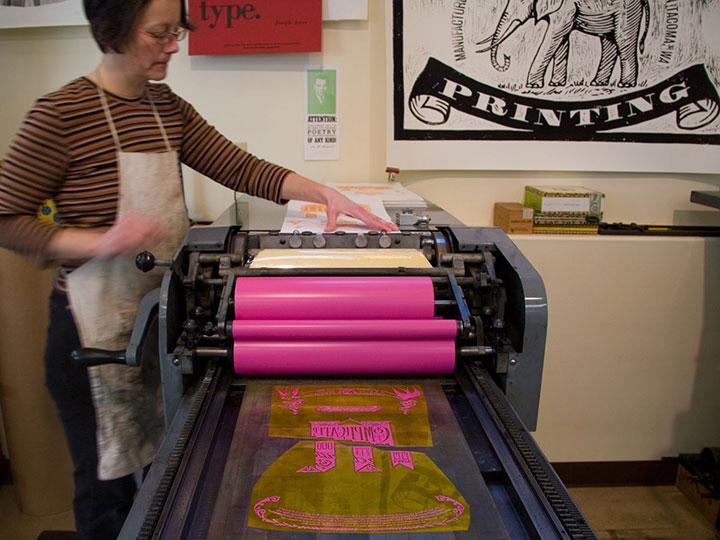
Jessica printing “Prop Cake” on her Vandercook Universal One press
As commercial printing became more streamlined, the cylinder and platen proof presses (see photo above) fell out of vogue, and eventually were no longer manufactured. Artists quickly saw their potential, however, and have adopted letterpress printing as an art form—using, refurbishing and maintaining this antique equipment to create original works of art.
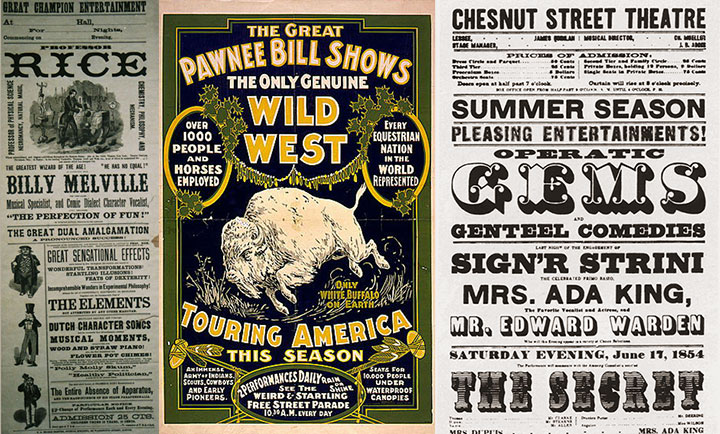
Hand-in-hand with letterpress printing, the art of the broadside has also survived and evolved into a modern format. The term broadside means any single sheet used to convey information, often of a political kind—the great-grandpappy of the modern poster. While today the words broadside and poster are sometimes used interchangeably, the broadside has remained a favorite of the letterpress community because of its emphasis on typography and content (hey, we need an excuse to use all that gorgeous metal type!).
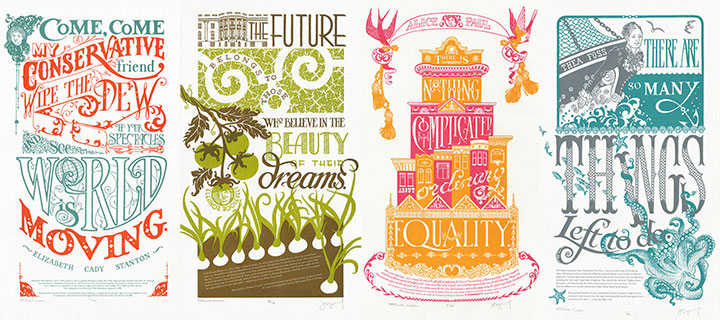
Jessica and I had this history in mind when we began the Dead Feminists series. As I said before, we never dreamed of starting down the path we’re on now; we just wanted to make a political and artistic contribution to the election. And to pay homage to the history of the broadside and the era in which each of our feminists lived, I designed each piece with historic broadsides and posters in mind. And to keep the series consistent, Jessica and I came up with a few rules of engagement:
1. Each poster has to feature a quote by a feminist. It doesn’t necessarily have to be a woman, but there are already plenty of posters highlighting the words of dudes, so we figured that one was covered already.
2. Said feminist must be deceased. (Hence the name.) You’d be surprised how many challenges that’s created for us.
3. Each quote is tied into a current sociopolitical issue or event. This is usually Jessica’s job, as she’s got a particular knack for finding relevant quotes.
4. The whole piece (except the colophon at the bottom, of course) is hand-drawn.
5. We try to stay away from well-worn tropes like “women can do anything men can do!” in favor of broader topics and concepts.
Who knows how long people will be interested in these things, or how many broadsides there’ll be in the series—all we can say is that we’re grateful for the response people have had, and we’re having way too much fun to quit now. The fun of art-making and the joy of the public response aside, the best part of creating this series has been exploring the lives and work of so many inspirational people. “Feminism” has become somewhat of a dirty word these days—mostly because of misconceptions. To us it’s a positive thing, and creating this series is our way of celebrating those who championed far more than just gender equality. Besides, we’d like to make our own contribution to our social history—and using the “power of the press” in the literal sense is the best way we know how.
• • • • • • • • • • • • • • • • • • • • • • • • • • • • • • • • • • • • • • • • • • • • • • • • • • • • • • • • • • • •
Coming in part two: the nitty gritty details behind our process.
May 12th, 2009

Well, here she be. (Or should I say, Thar she blows?)
At long last, Thea is here, barnacles and all. Jessica and I unveiled her at our Pressing Matters talk at the Tacoma Art Museum this morning. I have to say, I was nervous that with the weekday morning time slot, we’d be hoist on our own petard for the big debut. Since 10:30 on a Tuesday isn’t exactly an hour available to everybody, we were afraid we’d be lecturing a bunch of empty chairs. Boy were we wrong. Many thanks to all of you who skipped out on work, took a long (and very early) lunch, or otherwise carved out an hour of your day to spend with us—we raise our pirate flags to you. And to Allison Baer, TAM’s very own renaissance woman who made it all happen, you get the biggest Jolly Roger of them all. Thank you.
This week I’m going to post some of the things we talked about today at TAM, about the making of Tugboat Thea and our series. But for now, let’s just get down to brass tacks about the broadside. Here’s the quote that started it all:
There are so many things left to do. — Thea Foss
In honor of enterprising women everywhere, the print features business pioneer and entrepreneur Thea Foss, who founded the Foss Tugboat company in Tacoma, WA—at a time in history when it was not only courageous, but nearly unheard of for a woman to do so. Here Thea is portrayed as the figurehead of her own tugboat, surrounded by crashing waves and sea life native to her home waters of Puget Sound.
• • • • • • • • • • • • • • • • • • • • • • • • • • • • • • • • • • • • • • • • • • • • • • • • • • • • • • • • • • • •
Tugboat Thea: No. 4 in the Dead Feminists series
Edition size: 89
Poster size: 10 x 18 inches
Printed on an antique Vandercook Universal One press, on archival, 100% rag (cotton) paper. Each piece is numbered and signed by both artists.
Colophon reads:
Norwegian immigrant Thea Christiansen Foss (1857 – 1927) arrived by train to Tacoma in 1889 as Washington achieved statehood. While her husband Andrew was at work she spent five dollars on a rowboat, launching a marine transport business that would grow into Foss Maritime, operating the west coast’s largest fleet of tugboats. Thea inspired the character “Tugboat Annie” featured in a Saturday Evening Post series, motion pictures and a television show. Tacoma’s Thea Foss Waterway is an inlet connected to Puget Sound named in her honor.
UPDATE: poster is sold out. Reproduction postcards available in the Dead Feminists shop!
May 7th, 2009
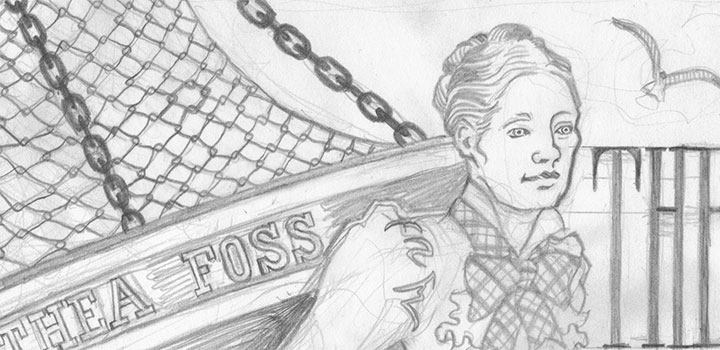
Thea’s back! This is just a sneak peek of the pencil sketch for now; Jessica and I are unveiling Ms. Foss’s new look on Tuesday, so we’re saving the surprise for then. In the meantime, though, we thought we’d offer up a few snippets.
The latest broadside in our Dead Feminists series has been a little bit of a different process, at least on my end. We had the chance to create a prototype of sorts when we were asked to make steamroller prints at the Wayzgoose this year. But while several hundred people were there to witness the steamroller in action, only eight huge Tugboat Thea prints exist—not exactly ideal in the supply-and-demand sense. By redesigning the piece, we we’d no longer be limited by what we could hand-carve out of a slab of linoleum. So we let the first Thea serve as a rough draft, and took another crack at it for the official series.
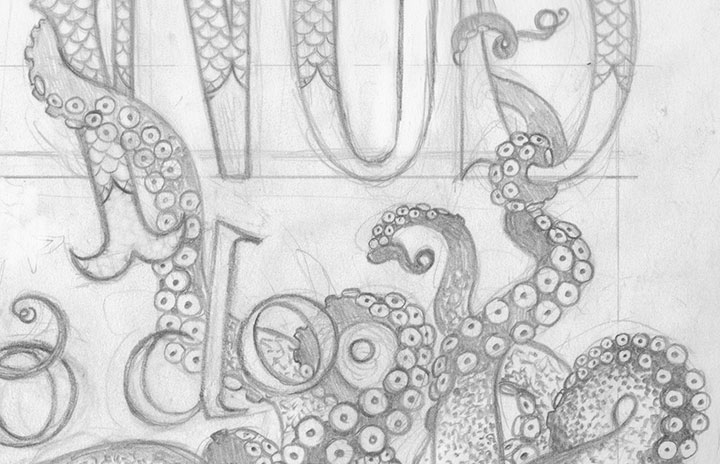
This time, though, there’s a bit of a twist. That’s all I’ll say for now.
As part of the unveiling of the new Tugboat Thea, Jessica and I will be speaking at TAM on Tuesday morning. If you’re in the area, and you can fit the weird time slot into your schedule (sorry about that), here are the details:
Pressing Matters:
Contemporary Collaborations Highlighting Women in History
Tuesday, May 12, 10:30 a.m.
Tacoma Art Museum, 1701 Pacific Ave.
Tugboat Thea will be available for sale at the event, too—look for it to appear here afterward!
![Chandler O'Leary [logo]](https://chandleroleary.com/wp-content/themes/chandleroleary/images/logo.png)






























































